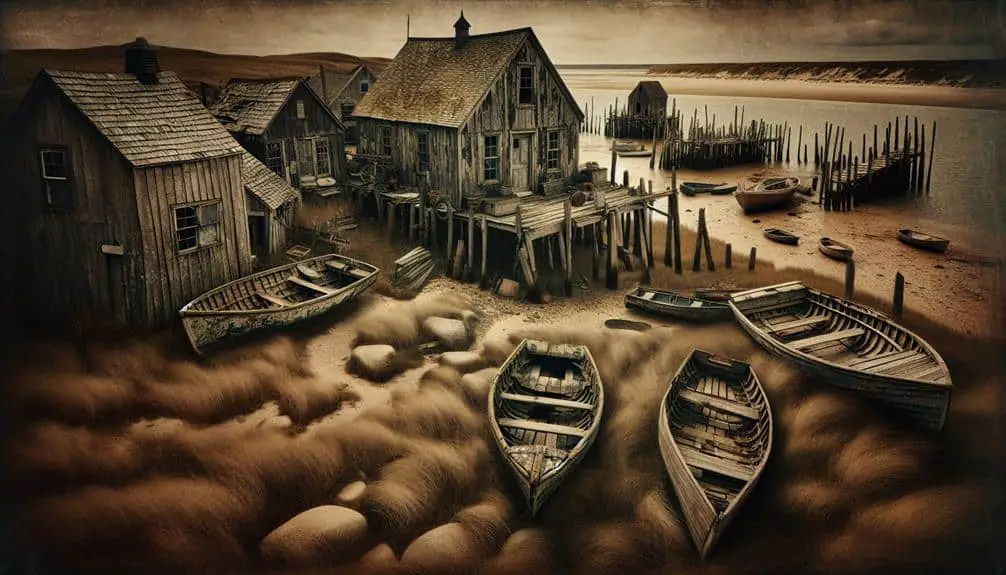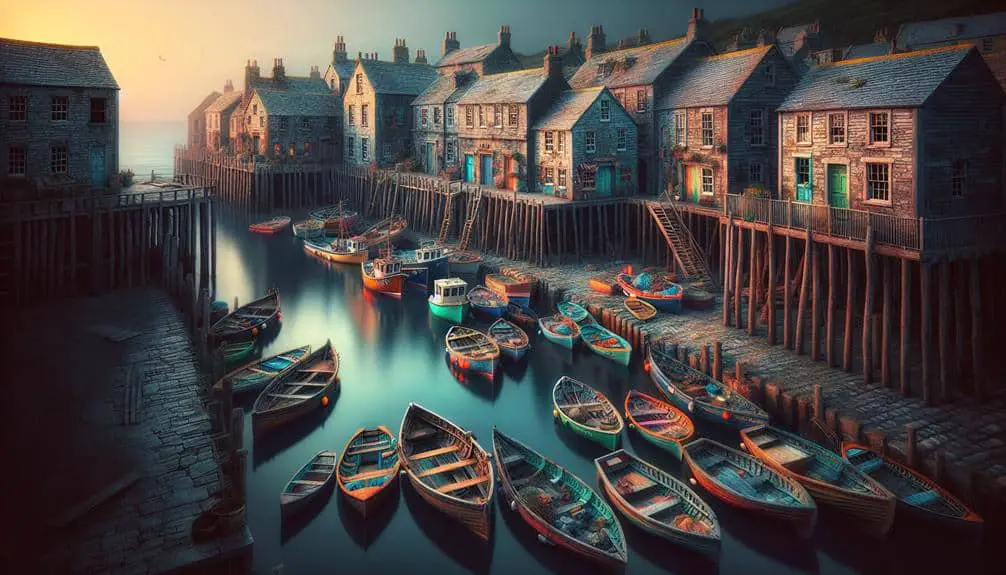Uncover the hidden gems of coastal fishing villages in the United States. Explore the remnants left behind, each one a confirmation to the rich maritime history and the resilient spirit of the communities. Investigate decaying structures and artifacts that whisper stories of tradition and struggle, painting a vivid picture of the past. Witness the architectural decay that narrates tales of bygone eras and celebrate the cultural significance preserved in these coastal enclaves. Each artifact holds a piece of the puzzle, waiting for you to discover the intricate details of these once-thriving villages.
Key Points
- Abandoned structures reveal maritime history and cultural heritage.
- Decaying boats and docks stand as relics of once-thriving communities.
- Economic decline and migration patterns impacted coastal villages.
- Cultural traditions and culinary expertise reflect village identity.
- Preservation efforts crucial for maintaining historical authenticity and sustainability.
History of Coastal Fishing Outposts
Throughout the evolution of coastal communities in the United States, the establishment of fishing outposts played a pivotal role in shaping the economic and cultural landscape of these regions. These outposts not only served as hubs for maritime heritage but also had significant environmental impacts.
Maritime heritage in coastal fishing villages is deeply rooted in the traditions and practices of these communities. The reliance on the ocean for sustenance and livelihoods created a unique bond between the people and the sea. Fishing outposts weren't just places of work; they were centers of community, where skills were passed down through generations, and a sense of identity was forged.
However, this close relationship with the environment also had its consequences. Overfishing and pollution from fishing activities have left lasting impacts on coastal ecosystems. The environmental impact of these outposts serves as a reminder of the delicate balance between human activity and nature in coastal regions. Understanding the history of coastal fishing outposts provides valuable insights into the challenges and opportunities faced by these communities as they endeavor to preserve their heritage while protecting the environment.
Abandoned Structures and Artifacts
Abandoned structures and artifacts dot the landscapes of coastal fishing villages in the United States, serving as poignant reminders of the once-thriving maritime communities that inhabited these shores. The architectural decay of these buildings tells a story of the past, with weather-worn facades and crumbling walls bearing witness to the passage of time. Rusty fishing equipment, decaying boats, and remnants of old docks stand as maritime relics, capturing the essence of a bygone era when these villages bustled with activity.
Exploring these abandoned structures can evoke a sense of nostalgia and wonder, transporting you back to a time when these villages were vibrant hubs of fishing and trade. The worn wooden planks of old houses, the faded paint of forgotten storefronts, and the silent docks that once welcomed bustling fleets all contribute to the eerie beauty of these ghostly remnants.
As you wander through these remnants of the past, you can't help but marvel at the resilience of these structures and the stories they hold within their walls. Each piece of architectural decay and each maritime memento serves as a tribute to the enduring spirit of these coastal communities, even as they fade into the annals of history.
Economic Decline and Migration Patterns
Amidst the remnants of decay and nostalgia in coastal fishing villages in the United States, economic decline and shifting migration patterns have played pivotal roles in reshaping the once-thriving communities. As industries evolved and technology advanced, traditional fishing practices gradually declined, leading to a decrease in employment opportunities. This decline in economic stability prompted population shifts, with many residents seeking livelihoods elsewhere. The migration patterns witnessed in these villages not only altered the demographic makeup but also eroded the social cohesion and community ties that had been the foundation of these close-knit settlements.
The dwindling employment opportunities, coupled with the allure of urban centers, prompted a significant exodus from these coastal villages. As younger generations sought better prospects, the population shifts resulted in a noticeable generational gap within these communities. The once vibrant villages, where fishing wasn't only an occupation but a way of life, now stand as reminders of the economic challenges and changing migration patterns that have shaped their present state.
Cultural Significance and Traditions
The cultural significance and traditions embedded within coastal fishing villages in the United States offer a rich tapestry of heritage that has withstood the test of time, reflecting a deep connection to the sea and a way of life intertwined with the rhythms of nature.
- Traditional Practices: From techniques of boat building to methods of fish preservation, these villages uphold age-old customs.
- Community Celebrations: Festivals and events centered around the sea create a strong sense of unity and belonging among residents.
- Oral Histories: Passed down through generations, stories of legendary fishermen and maritime adventures shape the identity of these communities.
- Artistic Expressions: Local crafts, music, and dance forms showcase the creativity and resilience of village inhabitants.
- Culinary Delights: Seafood recipes perfected over centuries are a tribute to the culinary expertise preserved within these coastal enclaves.
In exploring these aspects, one can truly appreciate the depth of cultural heritage that thrives in coastal fishing villages, keeping alive traditions that have defined these communities for generations.
Preservation Efforts and Future Prospects
Efforts to preserve the cultural heritage of coastal fishing villages in the United States are essential for safeguarding the legacy of traditional practices and ensuring the sustainability of these communities for future generations. Preservation initiatives play an important role in maintaining the historical authenticity of these villages, allowing current and future inhabitants to connect with their roots. By documenting the unique customs, architecture, and ways of life, preservation efforts help to honor the past while paving the way for sustainable practices in the future.
Sustainability practices are also integral to the preservation of coastal fishing villages. Implementing eco-friendly fishing techniques, promoting responsible tourism, and supporting local economies are key aspects of ensuring the longevity of these communities. By embracing sustainable practices, coastal fishing villages can thrive without compromising the environment or depleting resources. Looking ahead, the prospects for these villages rely heavily on the commitment to preserving their cultural heritage and implementing sustainable measures to guarantee a prosperous future for generations to come.
Frequently Asked Questions
What Are Some Common Seafood Dishes That Were Traditionally Prepared in Coastal Fishing Villages?
When living in coastal fishing villages, you'd savor traditional recipes passed down through generations. Culinary heritage thrived with dishes like clam chowder, fisherman's stew, and seafood boils, showcasing the ocean's bounty and community unity.
How Did the Construction of Modern Fishing Technologies Impact the Decline of Traditional Fishing Practices in These Villages?
Modern fishing technologies revolutionized the industry, altering traditional practices. Economic gains were significant, but cultural traditions waned. Societal changes accompanied technological advancements, leading to the decline of small-scale coastal fishing villages across the United States.
What Role Did Women Play in the Daily Life and Economy of Coastal Fishing Outposts?
Women in coastal fishing villages were essential to daily life and the economy. Their roles included managing household affairs, processing fish, and selling goods. Through their economic contributions, women sustained and enriched these communities.
Are There Any Ghost Stories or Legends Associated With the Abandoned Structures in These Villages?
You'll find an array of haunted tales and folklore linked to the abandoned structures in these villages. Locals whisper about paranormal sightings and mysterious disappearances, adding an eerie layer to the history of these coastal fishing remnants.
How Have Climate Change and Environmental Factors Affected the Preservation Efforts of These Coastal Fishing Village Remnants?
Climate change and environmental factors have greatly impacted preservation efforts in coastal fishing village remnants. Erosion accelerates decay, challenging community resilience. Historical structures face escalating threats, requiring innovative strategies to safeguard these cultural legacies for future generations.



